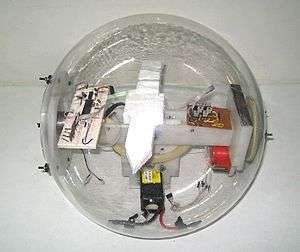Spherical robot

A Spherical Robot, also known as spherical mobile robot, or ball-shaped robot is a mobile robot with spherical external shape .[1] A spherical robot is typically made of a spherical shell serving as the body of the robot and an internal driving unit (IDU) that enables the robot to move .[2] Spherical mobile robots typically move by rolling over surfaces. The rolling motion is commonly performed by changing the robot's center of mass (i.e., pendulum-driven system), but there exist some other driving mechanisms [3] .[4] In a wider sense, however, the term "spherical robot" may also be referred to a stationary robot with two rotary joints and one prismatic joint which forms a spherical coordinate system (e.g., Stanford arm [5] ).
The spherical shell is usually made of solid transparent material but it can also be made of opaque or flexible material for special applications or because of special derive mechanisms .[6] The spherical shell can fully seal the robot from the outside environment. There exist reconfigurable spherical robots that can transform the spherical shell into other structures and perform other tasks aside from rolling.[7]
Spherical robots can operate as autonomous robots, or as remotely controlled (teleoperated) robots .[8] In almost all the spherical robots, communication between the internal driving unit and the external control unit (data logging or navigation system) is wireless because of the mobility and closed nature of the spherical shell. The power source of these robots is mostly a battery located inside the robot but there exist some spherical robots that utilize solar cells.[8] Spherical mobile robots can be categorized either by their application or by their drive mechanism.
Applications
Spherical mobile robots have applications [8] in surveillance, environmental monitoring, patrol, underwater and planetary exploration, rehabilitation, child-development,[9] and entertainment. Spherical robots can be used as amphibious robots [7] viable on land as well as on (or under) water.[10]
Locomotion
The most common drive mechanisms of the spherical robots operate by changing the robot's center of mass.[1] Other driving mechanisms [8] make use of: (1) conservation of angular velocity by flywheels,[3] (2) environment's wind, (3) distorting the spherical shell, and (4) gyroscopic effect.
Current research
The research on spherical robots involves studies on design and prototyping ,[11] dynamical modelling and simulation,[3] control,[12] motion planning,[2][4] and navigation.[13] From a theoretical point of view, the rolling motion of a spherical robot on a surface represents a nonholonomic system which has been particularly studied in the scope of control and motion planning.[2]
Commercial spherical robots
Commercial spherical robots are now available for sale to the public. Some of the current commercial ones are: Sphero, BB-8, GroundBot, Roball, and QueBall. The BB-8 is a droid character in the 2015 film Star Wars: The Force Awakens.
See also
External links
References
- 1 2 Halme, Aarne; Schonberg, Torsten; Wang, Yan (1996). "Motion control of a spherical mobile robot". 4th IEEE International Workshop on Advanced Motion Control (AMC '96-MIE). 1: 259–264. doi:10.1109/AMC.1996.509415.
- 1 2 3 Mukherjee, Ranjan; Minor, Mark A.; Pukrushpan, Jay T. (2002). "Motion Planning for a Spherical Mobile Robot: Revisiting the Classical Ball-Plate Problem". ASME journal of dynamic systems, measurement, and control. 124 (4): 502–511. doi:10.1115/1.1513177.
- 1 2 3 Joshi, Vrunda A.; Banavar, Ravi N.; Hippalgaonkar, Rohit (2010). "Design and analysis of a spherical mobile robot". Mechanism and Machine Theory. 45 (2): 130–136. doi:10.1016/j.mechmachtheory.2009.04.003.
- 1 2 Vahid Alizadeh, Hossein; Mahjoob, Mohammad J (2009). "Effect of incremental driving motion on a vision-based path planning of a spherical robot". Second International Conference on Computer and Electrical Engineering. IEEE. 1: 299–303. doi:10.1109/ICCEE.2009.133.
- ↑ "The Stanford arm".
- ↑ Ylikorpi, Tomi J; Halme, Aarne J; Forsman, Pekka J (2017). "Dynamic modeling and obstacle-crossing capability of flexible pendulum-driven ball-shaped robots". Robotics and Autonomous Systems. Elsevier. 87: 269–280. doi:10.1016/j.robot.2016.10.019.
- 1 2 Shi, Liwei; Guo, Shuxiang; Mao, Shilian; Yue, Chunfeng; Li, Maoxun; Asaka, Kinji (2013). "Development of an amphibious turtle-inspired spherical mother robot". Journal of Bionic Engineering. Elsevier. 10 (4): 446–455. doi:10.1016/S1672-6529(13)60248-6.
- 1 2 3 4 "Spherical Mobile Robots: Research, Design, Application".
- ↑ Michaud, François; Laplante, J-F; Larouche, Hélène; Duquette, Audrey; Caron, Serge; Létourneau, Dominic; Masson, Patric (2005). "Autonomous spherical mobile robot for child-development studies". IEEE Transactions on Systems, Man, and Cybernetics-Part A: Systems and Humans. 35 (4): 471–480. doi:10.1109/TSMCA.2005.850596.
- ↑ Vahid Alizadeh, Hossein; Mahjoob, Mohammad J. (2011). "Quadratic damping model for a spherical mobile robot moving on the free surface of the water". IEEE International Symposium on Robotic and Sensors Environments (ROSE): 125–130. doi:10.1109/ROSE.2011.6058541.
- ↑ Guo, Shuxiang; Mao, Shilian; Shi, Liwei; Li, Maoxun (2012). "Design and kinematic analysis of an amphibious spherical robot". IEEE International Conference on Mechatronics and Automation. IEEE (2214–2219). doi:10.1109/ICMA.2012.6285687.
- ↑ Kamaldar, M.; Mahjoob, M. J.; Haeri Yazdi, M.; Vahid Alizadeh, H.; Ahmadizadeh, S. (2011). "A control synthesis for reducing lateral oscillations of a spherical robot". IEEE International Conference on Mechatronics. 1: 546–551. doi:10.1109/ICMECH.2011.5971346.
- ↑ Hou, Kang; Sun, Hanxu; Jia, Qingxuan; Zhang, Yanheng (2012). "An autonomous positioning and navigation system for spherical mobile robot". Procedia Engineering. Elsevier. 29: 2556–2561. doi:10.1016/j.proeng.2012.01.350.